
Content below from Original at
Click
here or image above for original full page.
December 3, 2022
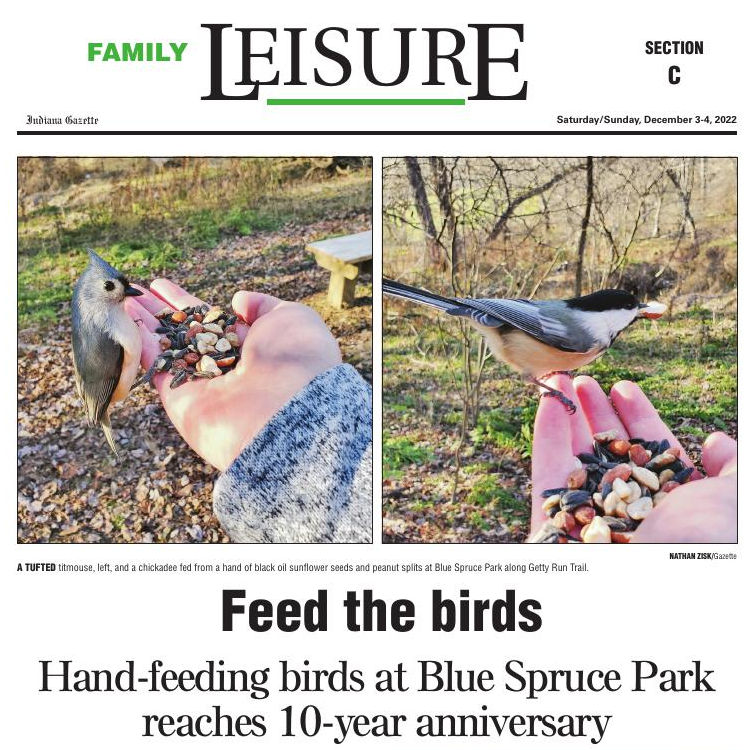
Indiana has a variety of outdoor activities people can enjoy year-round, but as the winter season rolls in and the air begins to chill, venturing outside can become less appealing.
Fortunately, there’s at least one outdoor winter activity that only gets better the more adverse the weather — feeding birds.
In Blue Spruce Park, along Getty Run Trail near the playground, wild birds have been conditioned over the past decade to take food from people’s hands.
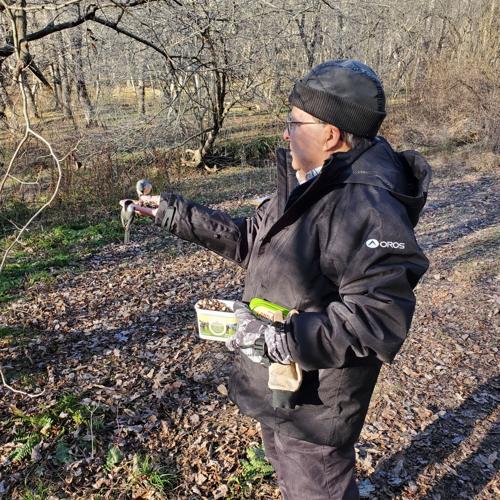
Ray Winstead, retired IUP Biology Professor
This year marks the 10-year anniversary of the activity and the 11th winter.
Those who hike the trail with black oil sunflower seeds and peanut splits are bound to encounter curious chickadees, tufted titmice and nuthatch birds looking for a good meal.
“The birds are a lot more active when it’s very cold,” said Ray Winstead, a former IUP biology professor who conditioned the birds more than a decade ago. “They’re storing up seeds in anticipation for hunkering down for a while.”
The birds all have seed preferences, but Winstead has found particular success using a mixture of small black oil sunflower seeds and peanuts that have been taken out of their shells and halved, i.e. “peanut splits.” He said store-bought bird feed doesn’t really interest the birds, but his specific blend of seeds from the Indiana Feed and Supply store along Water Street keeps them coming back.
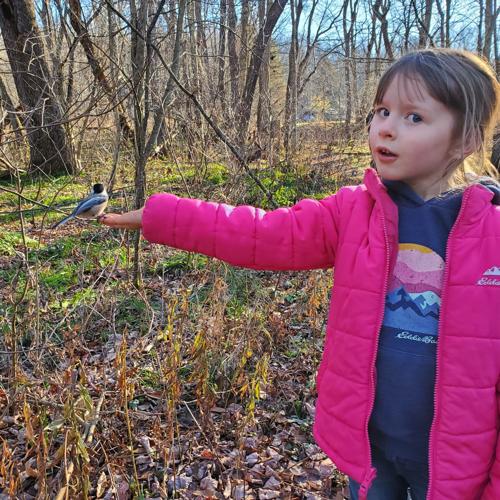
Penny Shetler, 5, and a Black-capped Chickadee
“The birds do have preferences (depending on) species, and even individuals from different species (have different preferences),” Winstead said.
“If you get bird seed without sunflower seed, they’re not going to like it. They’ll check it out, but they’re not coming back.”
Winstead began “training” the birds to eat from his hand in November 2012, and he discovered a few tricks that enhance the experience.
Winstead said shaking a container of bird seed alerts the birds to come over for food. After some birds have gathered, it’s best to stand still and hold out a handful of seeds. The birds are most comfortable landing on a steady, unmoving hand that is stretched out flat. The birds are more likely to eat from someone’s hand if the person is standing under a tree where the birds can land before taking seeds.
The birds may fly at someone’s hand a few times before landing to take seeds. Winstead said this is to test whether the person holding the seeds will stay still.
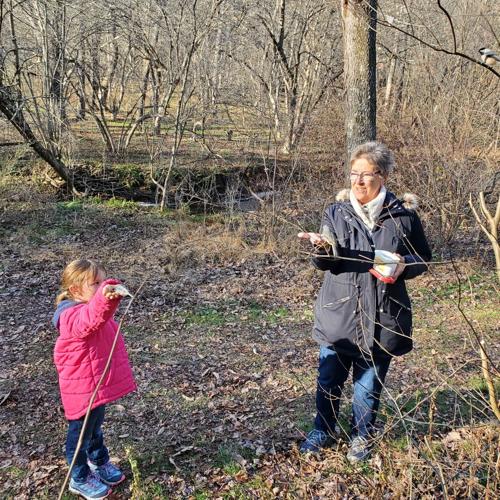
Penny Shetler, 5, and her grandmother Barb Knoch, of
Louisville, Ohio
Winstead and Indiana Parks and Trails Director Ed Patterson specifically asked that people avoid dumping or scattering seeds on the ground or benches — as it could untrain the birds to feed from people’s hands.
“The one thing we do ask is if people come up to feed the birds, don’t leave any extra seed lying around,” Patterson said. “It sort of spoils it for everyone else.”
The birds are most active during the winter season and are somewhat active during late fall and early spring. But there are a few factors that make feeding birds at Blue Spruce Park a winter activity.
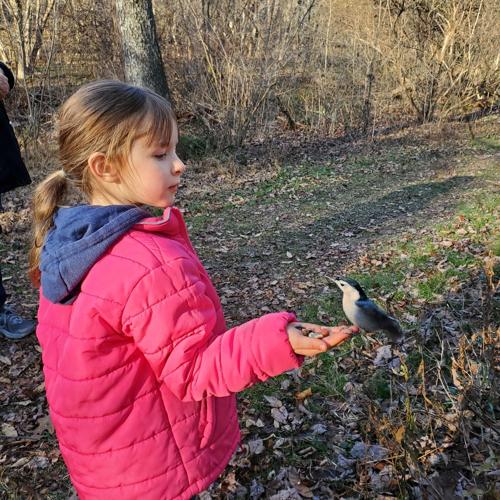
Penny Shetler, 5, and a White-breasted Nuthatch
First, the birds travel in flocks during winter, according to Winstead. With flocks of birds traveling, scouting and gathering together, it’s easier to encounter larger numbers of birds looking for food at the same time.
Second, during the winter season, there are fewer natural food sources available for the birds. So, they’re more likely to take food from people’s hands to cache for later. Third, as the weather becomes colder, harsher and more adverse, the birds become more determined to find food they can store in anticipation of winter storms.
Winstead, a member of Indiana’s Todd Bird Club, became interested in feeding birds after a 2011 trip to LaSalle Park near Burlington, Canada, with club members Margaret and Roger Higbee. During the trip, Winstead and the Higbees fed birds by hand, and Winstead wanted to replicate the experience in Indiana.
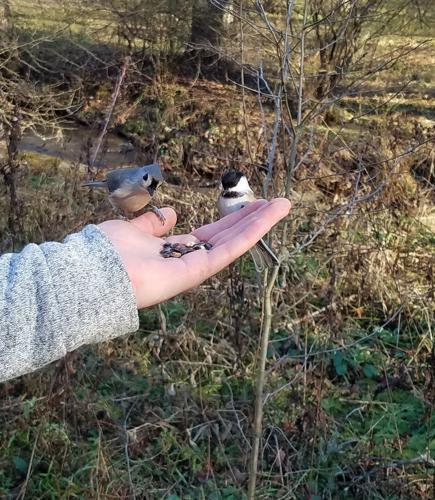
Tufted Titmouse and Black-capped Chickadee
Winstead had a plan to “train” the chickadees in Blue Spruce Park, according to his website.
For about a month every day, he put seeds on two tree stumps in the woods and stood close enough that the birds could see him but far enough to remain unthreatening.
Winstead moved a step closer to the stumps each day after placing down the seeds.
After about a month, Winstead was standing between the two stumps, and the birds comfortably came up next to him to take seeds. Eventually, the birds started to gather around the stumps when they saw Winstead, and he began offering the seeds by hand — the “training” was a success. Now, the birds fly around Winstead whenever he enters the woods — and not just chickadees, but tufted titmice and nuthatches, too.
“Since that start in Blue Spruce Park in 2012, birds readily come down to my hand any time I go out to see them during the winter,” Winstead’s website said.
“The good news is that the birds’ acceptance of me is transferable to other people.”
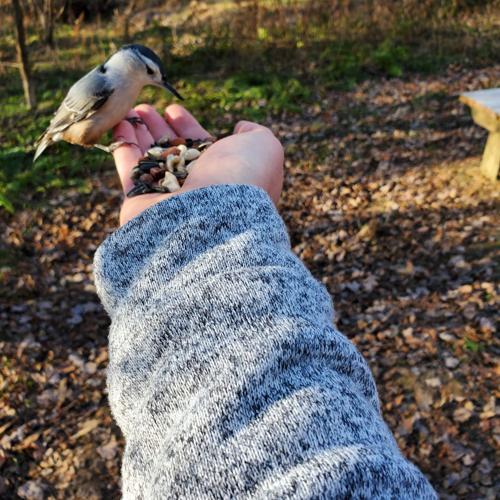
White-breasted Nuthatch
What started as a personal project for Winstead quickly turned into a popular activity in the park that spread through word of mouth.
“Immediately after success, I took family members out there and then told other friends, and it seems to have grown a lot,” Winstead said. “I would go out almost every day just because I like doing it, and other people started showing up walking the trails.
“I would tell them about it and give them seeds, and they would keep coming back.”
Patterson said feeding birds at Blue Spruce Park has even become somewhat of a tourist attraction, with annual programs bringing in groups from Pittsburgh, Johnstown and other surrounding areas to feed the birds. For the last few years, the Indiana County Decathlon and The Friends of the Parks organizations have sponsored and attended a “Hot Chocolate Walk,” formerly the “Chili Walk,” led by Winstead.
“I have seen the joy this activity brings to people,” Winstead’s website said, “and since I believe this activity brings us closer to nature in a delightful way, I believe we are more likely to do what is necessary to protect nature.”
Click here for Newspaper Front Page image.
Click here for backup image of original full page article.
| Front Page |
| Current Percentage Metric Time is |
|
O'Clock |
| Front Page |
Dr. Winstead's Blood Pressure Tracker: Free Templates for Graphing Blood Pressure in Microsoft Excel
Dr. Winstead's Current Local and World Standard Percentage Metric Time Clock